Tomatoes are the most popular vegetable grown in gardens, but even small or no-space gardeners can enjoy a homemade Tomato crop when planted in containers/pots. Tomatoes are a vegetable that thrives when grown in pots and you can help ensure success when you choose the best varieties for containers. Tomatoes are heavy feeders that usually require enough fertilizer to get during the season. The hard part is to find out which fertilizer is best, how much to use, and when to apply it.
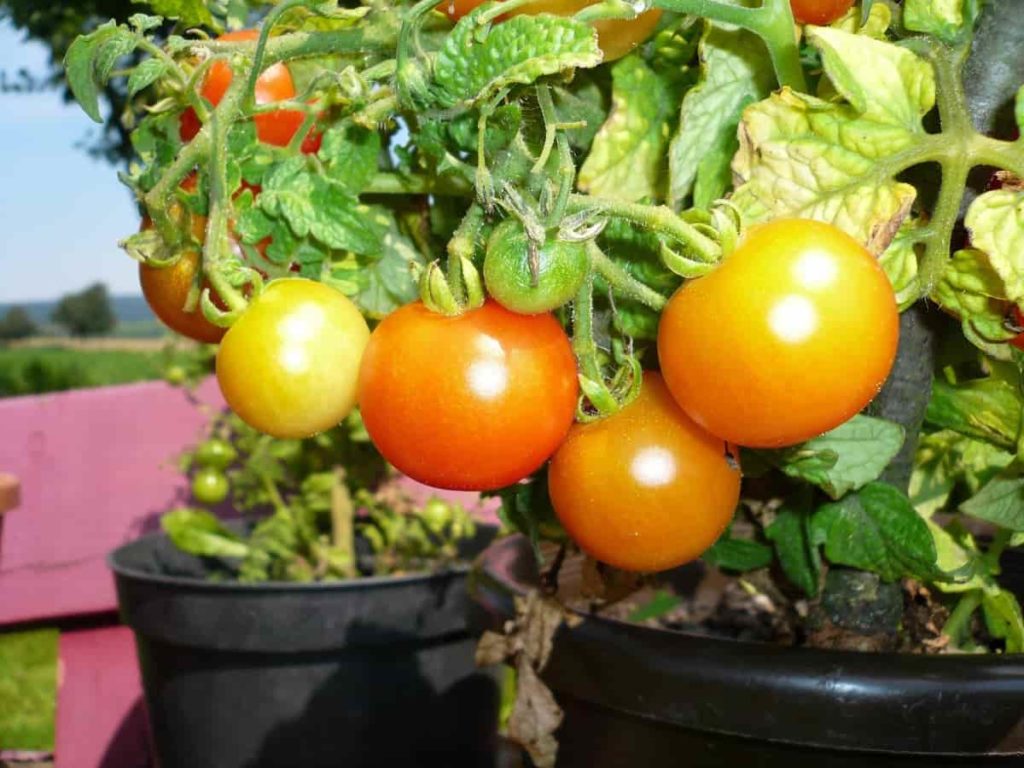
Fertilize your Tomatoes to get the best results. The best fertilizer sits in the overall plant growth, opening, fruit production, and disease resistance for Tomatoes. A healthy Tomato plant will provide a great crop of beautiful fruit. Additional investigation selections are needed to select the best fertilizer for your plants of tomato and growth conditions. Tomatoes are heavy feeders, and they require so many nutrients to grow accurately. If you fail to give fertilizer, your plant crop will be small. Let’s check out the best fertilizer for tomatoes in pots.
What nutrients do tomato plants need?
Tomatoes require three basic nutrients Nitrogen, Phosphorus, Potassium, and lots of other nutrients. Each provides an important task for plants.
Nitrogen
This nutrient helps in the maintenance of leaves on the plant, but if you have too much nitrogen, it will make a bushy plant that will not contain fruit.
Phosphorus
Your plant needs phosphorus for the growth of roots and fruits. It is a necessary nutrient in the first phase and in the last phase of development.
Potassium
These nutrients help the plant grow faster and produce flowers that eventually turn into fruits.
Small nutrients
NPK is the large macronutrients that all plants need in large quantities, but plants also need small nutrients and elements to grow. Some of the plants that tomato plants need include:
- Calcium – It is essential for proper root and leaf development. It also helps in producing strong Tomatoes.
- Magnesium – Without magnesium, your plant will no longer be green. It also helps in improving the quality of flowers and fruits.
- Zinc and Boron – These elements help your plant in flowering processes and fruit ripening.
In case you miss this: Tomato Farming In Karnataka, Areas, Seasons, Yield
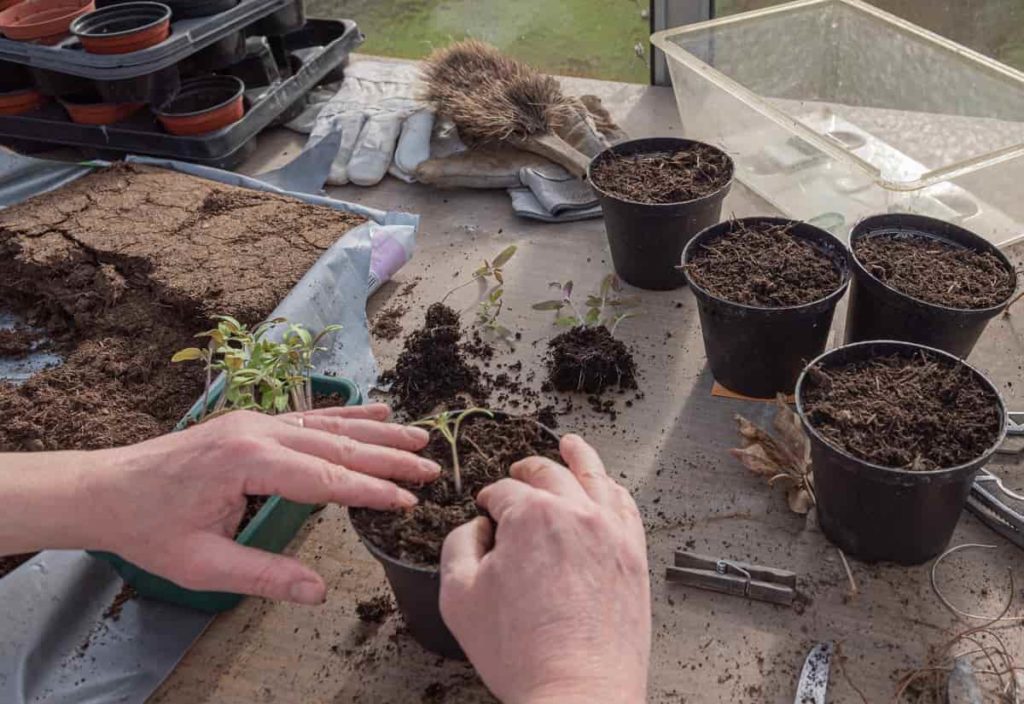
Benefits of homemade fertilizers
- It was cheap
- No risk of overfertilization
- Prepare soil structure
- Slow Ongoing Fertilizer
- Supply of nutrients during the season
- eco-friendly
- Helps grow more nutritious and delicious fruits
The best fertilizer for tomatoes in pots
Nitrogen-containing ingredients
- Rabbit Poo
- Manure
- Corn gluten meal
Phosphorus-containing ingredients
- Human urine
- Soya beans
- Kelp meal
- Pumpkin or Squash seeds
- Sunflower seeds
Potassium containing ingredients
- Banana peels
- Orange peels
- Potato peels
- Cucumber peels
- Sweet potato peels
- Wood ash
In case you miss this: How to Use Wood Ash in Your Home Garden for Maximum Benefit

Ingredients that have been traced to micronutrients
- Compost
- Eggshells
- Black-strap molasses
- Seaweed
- Coffee grounds
- Aquarium Water
- Cooking water
- Epsom salt
- Hair
- Fishhead
- Organic cottonseed meal
Which ingredients should avoid making homemade fertilizers?
- Pet manure is like cats and dogs because they are poisonous
- Human manure
- Any animal manure that is not pure vegetarian
- Plastic
- Metal
- All dairy products
- Glass
- Chemical Products
- Biohazards (animal blood, tissues, pathological waste, etc.)
How often do fertilize Tomatoes in pots/containers?
There are few often much better when it comes to composting Tomatoes in pots. Unusual, large doses instead of regular doses of small amounts of fertilizer like Tomatoes. Some gardeners swear by weekly feeding or even more often. Make time to find out the best schedule that works for your plants. There are plenty of variables including Tomato type, container size, plant size, weather, and potting mix type.
You will find that you are feeding plants too much when they produce more leaves than fruits. If the production is low or the leaves start to yellow, you’re probably not feeding enough. Healthy, homegrown Tomatoes depend on fertilizer. Your Tomatoes won’t be so abundant if you don’t compost your plants. However, too much fertilizer can result in poor fruit production, so knowing how often it is important to compost your plants.
In case you miss this: Tomato Growing Tips, Ideas, Secrets, and Techniques
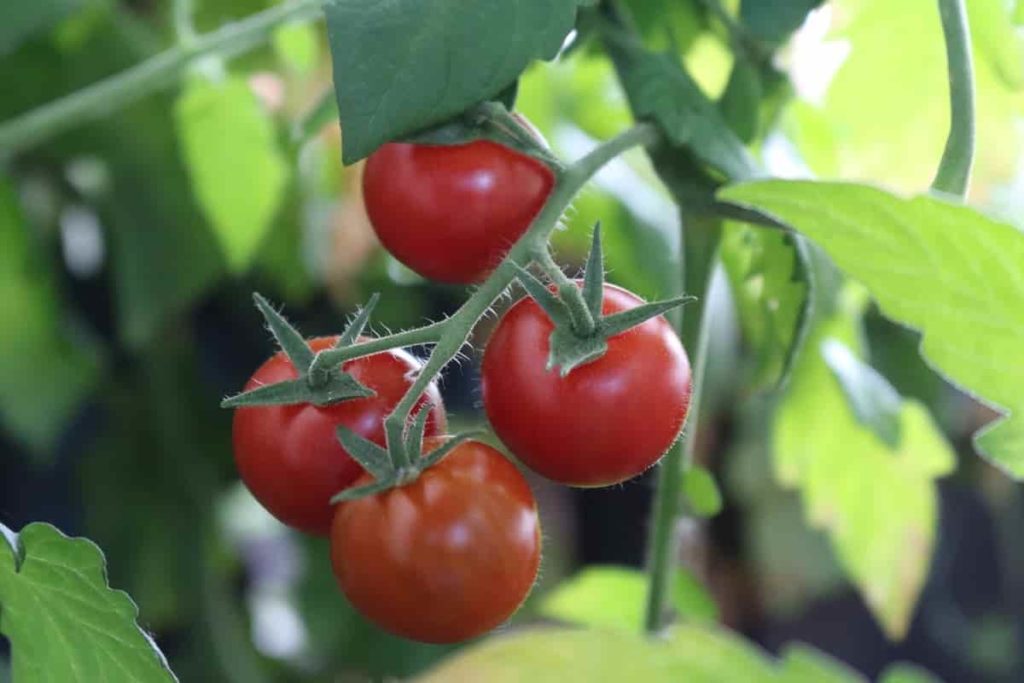
First, experts recommend applying about 3 pounds of full manure to Tomato plants when preparing beds for planting in spring, which should be tailed up to a depth of 12 inches. This will ensure that your beds are full of nutrition, a necessary step in growing healthy Tomatoes.
Once the first fruit is almost the size of a golf ball, you can apply an extra amount of fertilizer; it will help boost fruit production. You can then add light manure every one to two weeks till the end of the crop period. Avoid getting manure on leaves and always make sure your plants are well watered before composting.
Growing Tomatoes at home in pots
- Tomatoes are hot weather crops and are generally grown as annual summer crops. Tomato seeds should be started indoors between March and June.
- Initially, plant indoor Tomato seeds to 3 to 4 inches deep or small seed pots that start trays about 1⁄4 inches deep in moderately fertile soil.
- Tomatoes have the best soil pH from 6.0 to 6.8. Apart from heavy soil, Tomatoes will grow in almost any kind of garden soil.
- The ideal temperature required for tomato seed germination ranges from 21°C to 27°C. Place the pots in a dry and dark place for the best germination results. Tomato seedlings may appear in 10 to 14 days.
- In soil, there is a secret to growing good Tomatoes at home. For the production growth of Tomatoes, it is important to maintain maximum soil moisture.
- Until growing, seeds require very little water. Use a spray bottle to retain the top of the soil moist. If you think the soil has become too moist, just keep the pot plant in the area with better ventilation.
- When Tomato plants are 2 to 3 inches long, you need to insert some support into your plant.
- Use Tomato cage or stakes for defined tomato varieties.
- Use string trellis, long stake, or strong cage for unspecified types.
- Wrapping nylon nets on plants can protect plants from insects and pests.
In case you miss this: Homemade Fertilizer for Tomato – Manure, Compost
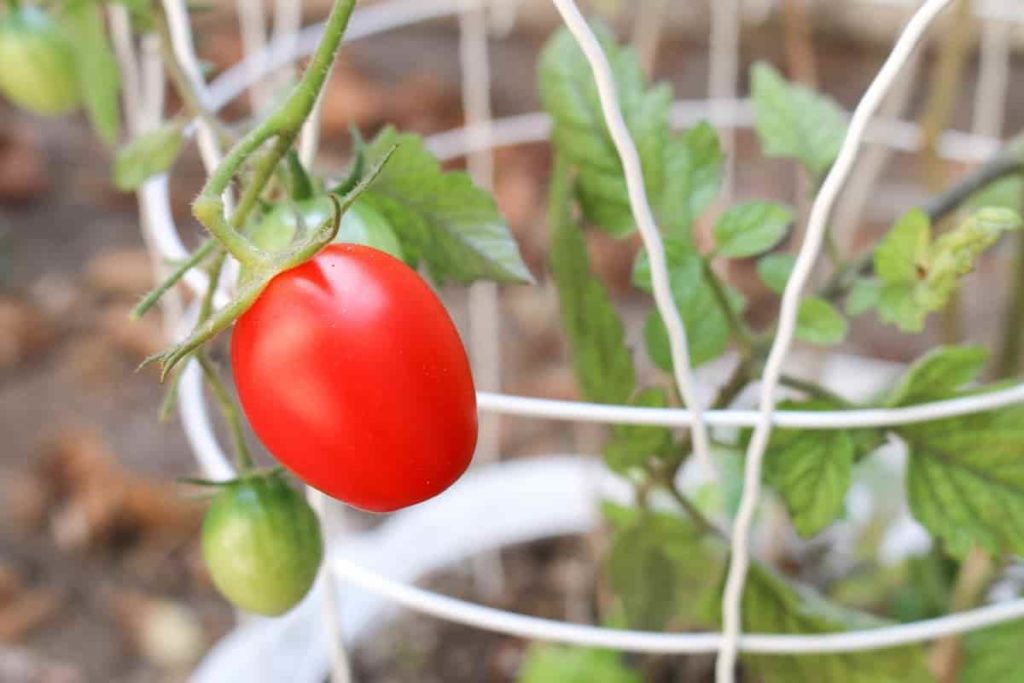
8-32-16 fertilizer for Tomatoes grown at home in pots
This fertilizer is used during the development phase for pre-flowering and flower to ripe fruit phase
- You can meet nutritional needs when it comes to the determinate of Tomato plants as there is a difference between the growth phase and fruit. But for unspecified varieties, needs permanent plant feed using fertilizers of 8-32-16 or 6-24-24. Therefore, the nitrogen content is made up of 1/4 of phosphorus with at least 1/2 potassium.
- Moreover, if you want a lot of flowers, it needs a permanent source of nitrogen but not too much. Before flowering by the end of the season, it also helps to add potassium. The level should be twice as high as nitrogen, such as 8-32-16 or 6-24-24, and add per instruction. Or you can make some compost tea by chopping the banana peel into pieces and burying it in the soil. Then, during the plant’s growth, you can keep collecting them and put them in a large container to cover them. Then, you can push the peel closer to the roots that are about an inch below or deep erased from the soil.
- One of the main nutrients to add is phosphorus for good fruit. The same applies to potassium inclusion but only once a week. For the best fertilizer during this phase, you can go for 8-32-16 plant feed. Once you determine how long it takes for your plant to flower, you can start feeding them up to two weeks before time.
How often should water Tomatoes be grown in pots or containers?
Water frequency depends on the size of the container, the state of the weather, and the type of Tomato grown in the pot. The bush-type Tomatoes grown in a 5-gallon container need water daily, sometimes twice a day in the hot summer months, and when the plant is actively producing Tomatoes. A pot needs a gallon of water about a large, well-established Tomato plant a day. As a general rule of thumb, water the container slowly until water is drained out of the drainage holes below.
In case you miss this: Growing Roma Tomatoes In Pots – From Seeds At Home
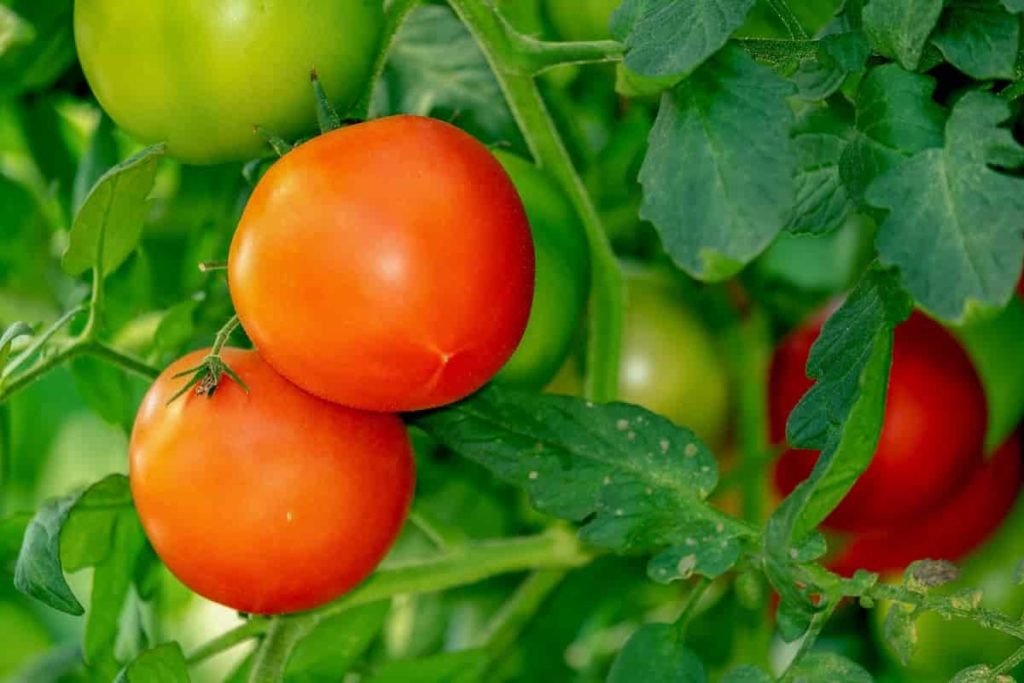
The best way to check whether the plant needs water is to stick its finger to 2 inches depth in the potting soil. If the soil feels dry, it is water time. Bending leaves are a clear visual sign that the plant is thirsty. If you see the leaves of your tomato plant getting yellow, it can be a sign that the water needs of the plant are not met.
Another easy alternative is to invest in soil moisture meters. Just stick the prong in the soil, and the dial will show you the amount of moisture in the potting soil. This is the easiest way to measure the water level in the pot properly.
- Flower Garden Designs and Layouts for Beginners
- Planting and Spacing Techniques in Papaya: A Beginner’s Guide
- Growing Gold: Essential Techniques for Planting Pineapples
- How to Make Kalanchoe Plant Bushy: Home Remedies and Solutions
- 11 Reasons Why Your Gardenia is Not Blooming: Home Remedies and Solutions
- Eco Elegance: The Guide to Designing a Drought-Tolerant Landscape
- Gardening on a Slope: Strategies for Hillside Landscaping
- Nourish and Flourish: Top Organic Mulches for Thriving House Plants
- Everything You Want to Know about Indian Mogra Flower: Discover Uses and Growing
- Green Thumb Success: Expert Tips for Cultivating Greenhouse Pumpkins All Year Round
- Maximize Growth & Flavor: The Ultimate Guide to Companion Planting in Herb Gardens
- How to Control Rhododendron Problems Naturally: Home Remedies and Organic Ways to Fix Them
- Natural Magic: The Remarkable Benefits of Cinnamon for Plants
- Best Steps to Revive Dying Tulip with Natural and Organic Treatment
- 10 Reasons Why Your Angel Trumpet is Not Blooming: Remedies and Treatment
- How to Fix Periwinkle Leaf and Flower-Related Problems: Natural Remedies and Solutions
- How to Fix Zinnias Leaf and Flower Problems: Discover Natural and Home Remedies
- Organic Steps to Induce Lemon Tree Flowers: A Comprehensive Guide
- Bloom Booster: Crafting the Perfect Homemade Bougainvillea Fertilizer
- Optimizing Growth: A Guide to Applying NPK Fertilizer for Potted Plants
- 10 Best Homemade Fertilizers for Rubber Plant: DIY Recipes and Application Method
- How to Boost Female Pumpkin Flowers: Effective Steps for More Flowers and High Yields
- Transform Your Indoor Garden: Top Benefits of Pink Salt for Houseplants
- 10 Best Homemade Fertilizers for Peacock Plants (Calathea): Easy DIY Guide
- Unlock Blooms: 9 Reasons Why Your Potted Chrysanthemum is Not Blooming
- 8 Reasons Why Your Potted Hibiscus is Not Blooming: Fix it with Simple Solutions
- Unlock Blooms: 9 Key Reasons Your Potted Frangipani Won’t Flower
- 10 Reasons Why Is My Ice Plant Not Blooming: Remedies and Treatment
- 10 Reasons Why My Potted Hydrangea Not Blooming: Treatment and Remedies
- 10 Reasons Why is My Wisteria Not Blooming: Remedies and Treatment
- 10 Reasons Why is My Goldfish Plant Not Blooming: Remedies and Treatment
- Maximize Your Space: Ultimate Guide to Balcony Gardening with Grow Bags
- 10 Reasons Why Your Iris is Not Blooming: Remedies and Treatment
- 10 Reasons Why Your Anthurium Plant is Not Blooming: Treatment and Remedies
- 10 Reasons Why Your Aquaponic Plants Are Not Flowering: Remedies and Treatment
- 10 Reasons Why Your Agapanthus is Not Flowering: Remedies and Treatment